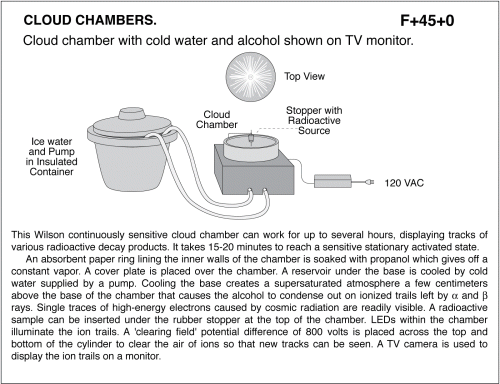Expansion cloud chamber with water and compression bulb.
Primary tabs
Expansion cloud chamber with water and compression bulb. Squeezing slowly and then releasing suddenly the bulb of this Wilson expansion cloud chamber causes alpha tracks from a radioactive source to become briefly visible. This is a simple Wilson expansion cloud chamber. The top sealed glass cylinder is filled with air. There is a small radium-salt radioactive source sealed inside a thin glass tube and attached to the cylinder wall. The source emits positive _ rays (helium nuclei), and _ rays (photons). The __rays knock electrons off of nitrogen and oxygen in the air, leaving a trail of negative and positive ions, but the _ rays produce few ions. The __rays leave a strong trail of ions, and the _ rays do not leave an ionized trail. In the base and rubber bulb of the device is water. When the bulb is squeezed, the water is pushed up and compresses the air in the cylinder. When the bulb is released, the air temperature is temporarily lowered and the air becomes supersaturated with water vapor. The water vapor condenses on the positive and negative ions left by the __rays, leaving visible trails. A light source helps to illuminate the trails. A 'clearing field' potential difference of 100 volts is placed across the top and bottom of the cylinder to clear the air of ions so that new tracks can be seen. Ref.:Modern College Physics by Harvey White, 6th ed., p. 799-805
UCB Index:
F+45+0
PIRA Index:
7D30.50
UCB Taxonomy:
PIRA Taxonomy:
Popularity:
- Log in to post comments

